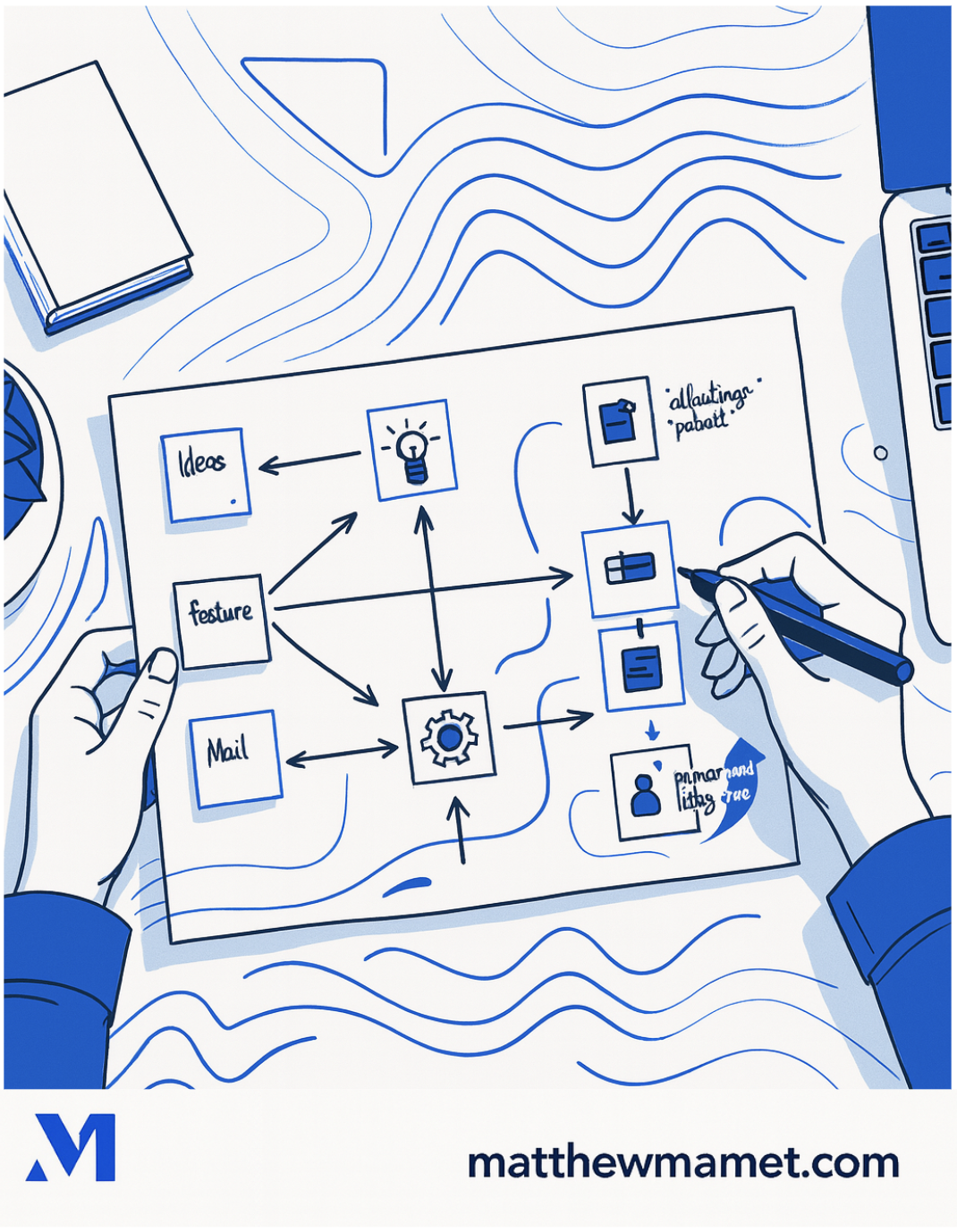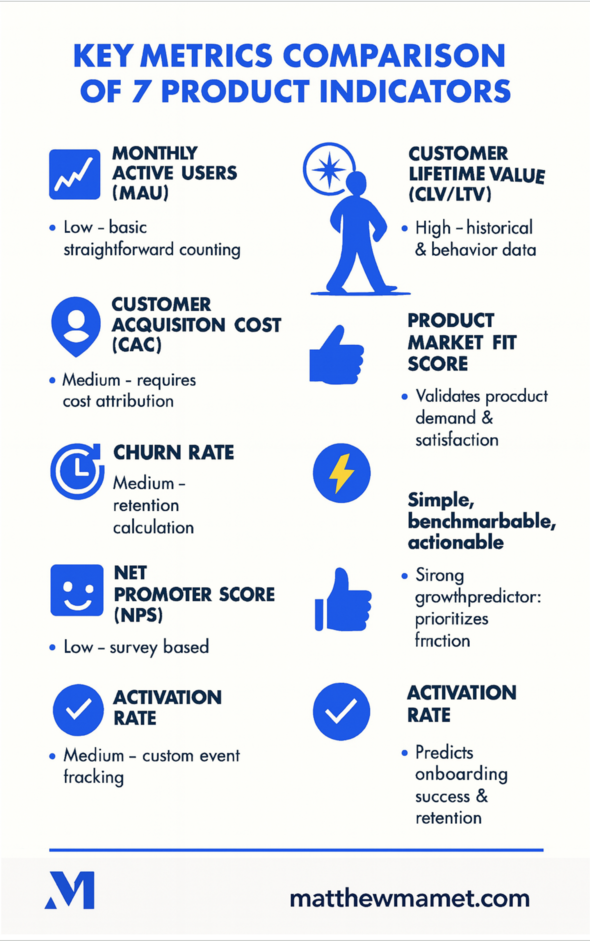Table of Contents
Understanding What Makes a Product Roadmap Actually Work
Let's get one thing straight: a product roadmap isn't a project plan dressed up with nice visuals. It’s definitely not a list of features with arbitrary deadlines attached. A truly effective roadmap is a strategic communication tool, a statement of intent that connects your team’s daily work to your company’s highest-level goals.
Many roadmaps fail because they are treated as static documents—a checklist to be completed rather than a living guide for decision-making.
The most common mistake is thinking a roadmap's main job is to provide delivery dates. While timelines are part of the picture, a great roadmap focuses on the why behind the what. It tells a compelling story about the problems you're solving for customers and the business outcomes you expect to achieve. This shift from features to outcomes is what separates strategic product leaders from project managers. An outcome-focused roadmap might have a theme like "Improve New User Activation" instead of just listing "Build a new onboarding tutorial."
From Wishlist to Strategic Guide
So, how do you make sure your roadmap is a strategic weapon and not just a glorified wishlist? Start by treating it as a persuasive argument. You're making a case for why a specific set of initiatives, in a particular sequence, is the best path forward to win in your market. This requires a deep understanding of your business goals, customer needs, and resource limits. It's a blend of data and vision.
For example, a roadmap that successfully guided a SaaS product through a competitive market didn't just list "Add AI Assistant." Instead, it framed the initiative under the theme "Reduce Customer Time-to-Value." The success metric wasn't "launch the feature," but "decrease average support ticket resolution time by 25%." This focuses the entire team on solving a real problem, not just shipping code, and provides a clear way to measure success after launch.
The Rise of Purpose-Built Tools
The growing importance of strategic roadmapping is reflected in the market for specialized software. The global product roadmap software market was valued at around USD 1.3 billion in 2024 and is projected to nearly double by 2031. This growth shows a major shift; companies are moving away from static spreadsheets toward dynamic tools built for communication and strategic alignment. You can explore more about this market trend in this detailed product roadmap software market analysis.
A modern roadmap tool often provides different views for different audiences, which is crucial for effective communication.
This screenshot shows how a single source of information can be tailored for executives (high-level themes) or engineering teams (detailed initiatives). The key insight here is that you don't need multiple conflicting roadmaps; you need a single, flexible one. This approach also helps in proactively managing uncertainty. If you're looking for deeper insights, our guide to effective product risk management offers practical frameworks for spotting and handling potential roadblocks.
Ultimately, a working roadmap builds confidence and clarity across the entire organization.
Gathering Intelligence That Actually Matters
A great product roadmap isn't built on wishful thinking or a list of pet features from the highest-paid person in the room. It’s built on a foundation of genuine intelligence—the kind that reveals what customers truly need, not just what they say they want. To create a product roadmap that leads to real market success, you have to become a master at separating the signal from the noise.
This means going deeper than surface-level feedback. Think of yourself as a detective piecing together clues from multiple, sometimes conflicting, sources. The goal isn’t just to collect data; it's to turn it into actionable insights that point toward hidden opportunities.

Uncovering What Customers Really Need
The most common trap is taking feature requests at face value. When a customer asks for a "faster horse," they aren't really asking for an equine upgrade; they're expressing a need for quicker travel. Your job is to understand the underlying problem. Meaningful customer interviews are your best tool here. Instead of asking, "What features should we build?" ask questions that uncover their workflow, frustrations, and goals.
I once worked with a team whose customers kept asking for more complex data export options. A surface-level analysis would have led to a massive engineering effort to build a convoluted CSV generator. However, by conducting just five "Jobs to be Done" interviews, we discovered the real need: customers didn't want more data, they wanted clearer insights to share with their bosses.
The winning solution wasn't a better export tool; it was a simple, sharable dashboard with presentation-ready visuals. This insight saved months of development and delivered far more value.
Synthesizing Intelligence from Multiple Channels
A single source of feedback is a single point of failure. Top product teams create a complete picture by combining data from various channels. Each source provides a different piece of the puzzle:
- Sales Conversations: Your sales team is on the front line, hearing directly about the objections and needs that prevent prospects from buying. They understand the competitive pressures and the "must-have" features that close deals.
- Support Tickets: This is a goldmine for understanding user friction. What parts of your product are confusing? Where are users getting stuck? If you see 25% of support tickets clustering around a single feature, that's a huge red flag telling you where to focus.
- Usage Analytics: While interviews tell you why, usage data tells you what. Are customers using that feature you spent three months building? Where do they drop off in the onboarding flow? This data validates or invalidates your assumptions about user behavior.
- Competitor Moves: Don't just copy competitors. Instead, analyze why they made a particular move. Did they launch a feature to enter a new market segment or to solve a core problem you've been ignoring? Look for the strategic intent behind their actions.
This process of gathering and combining information is where dedicated tools become incredibly helpful. Product roadmap software plays a crucial part by helping product managers plan timelines, document goals, and maintain the product lifecycle in alignment with the company's vision. It creates transparency by providing stakeholders with real-time status updates and a clear view of feature prioritization, which helps focus teams on high-value outcomes. You can find out more about how these tools are changing the game in this detailed report on the product roadmap software market.
Ultimately, gathering intelligence is about developing a deep, empathetic understanding of your market and customers. When you can confidently articulate the "why" behind every item on your roadmap, you've moved from simply listing features to building a true strategy for growth.
Defining Objectives That Drive Real Outcomes
A product roadmap without clear objectives is like a ship without a rudder—it might look impressive, but it’s not going anywhere specific. This is a common trap teams fall into. They pack their roadmaps with grand statements like "Become the market leader" or "Delight our customers." While inspiring, these goals don't give an engineering team any real direction on a Monday morning.
Effective objectives are the crucial link between your company's high-level strategy and the daily work of your product teams. They translate broad business ambitions into specific, measurable product outcomes. This precision is what separates a roadmap that gathers dust from one that powers real growth. Your objectives shouldn't just sound good in a presentation; they must be sharp enough to guide the tough trade-off decisions that come up every day.
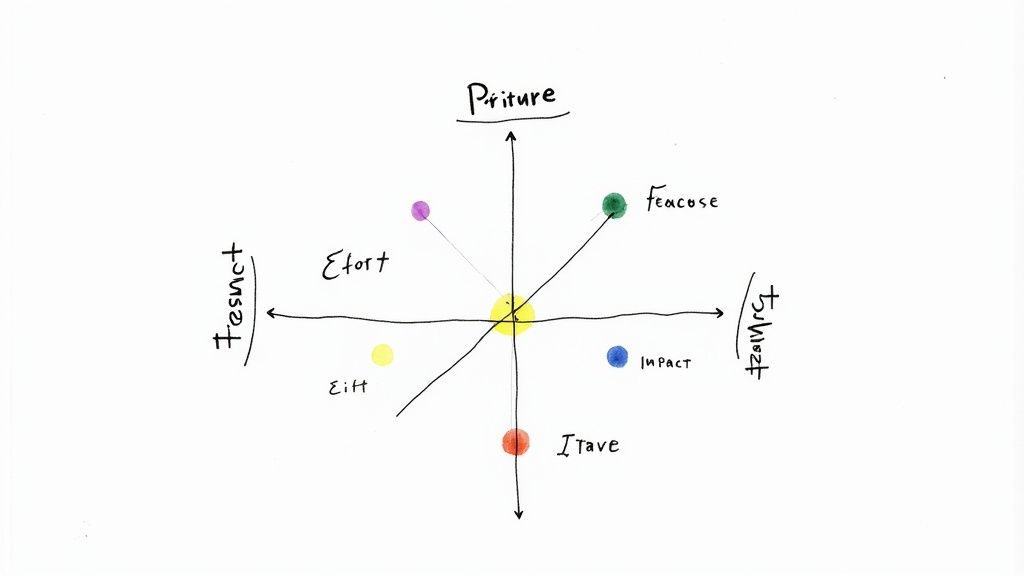
From Aspiration to Actionable Outcomes
The real work is moving from abstract wishes to concrete results. Let's say a top-level business goal is to increase market share in the SMB segment. A vague roadmap objective might be "Build features for small businesses." A much stronger, outcome-driven objective would be, "Reduce new user onboarding time from 20 minutes to 5 minutes in Q3 to increase SMB activation rate by 15%."
This stronger objective accomplishes several things brilliantly:
- It names a specific user experience to fix (onboarding time).
- It sets a measurable target (from 20 to 5 minutes).
- It links the product work directly to a business KPI (activation rate).
- It provides a time constraint (Q3), creating focus and urgency.
With this level of clarity, every person on the team—from designers to developers—understands the mission. They can brainstorm solutions and make decisions aligned with a shared definition of what success looks like.
Using Frameworks to Connect Strategy to Goals
Frameworks like Objectives and Key Results (OKRs) are popular for a reason—they enforce this kind of discipline. OKRs push you to define an ambitious, qualitative Objective and pair it with quantitative Key Results that prove you actually achieved it. When done right, an OKR cascades from the company level all the way down to the product team.
Here’s a practical example for a mobile app team:
- Company Objective: Increase recurring revenue.
- Product Objective: Improve user retention and drive premium upgrades.
- Key Results:
- Increase Day 30 user retention from 10% to 18%.
- Increase the free-to-paid conversion rate from 3% to 5%.
- Achieve a Net Promoter Score (NPS) of 45+ from paying users.
Now, your roadmap themes and initiatives have a clear purpose. You can prioritize features based on which ones are most likely to move these specific numbers. To help visualize how different objective-setting methods connect to results, the table below compares a few common frameworks.
| Objective Type | Key Metrics | Time Horizon | Success Rate |
|---|---|---|---|
| OKRs (Objectives & Key Results) | Engagement, Conversion, Retention | Quarterly | 70-80% (ambitious) |
| MBOs (Management by Objectives) | Revenue, Profit, Market Share | Annually | 80-90% (achievable) |
| SMART Goals | Specific task completion metrics | Project-based | 90%+ (highly specific) |
| KPIs (Key Performance Indicators) | Daily/Weekly Active Users, Churn | Ongoing | N/A (monitoring) |
| Table: Roadmap Objective Types and Success Metrics | |||
| Comparison of different objective frameworks with their measurement approaches and typical outcomes |
As the table shows, frameworks like OKRs are designed for ambitious, quarterly goals, while others like MBOs focus on longer-term, more concrete business targets. This data-informed approach builds confidence across the organization and provides a solid foundation for your planning. For those wanting to dig deeper, exploring a proven framework for growth can offer the structure needed to connect these dots effectively.
Ultimately, defining sharp objectives transforms your roadmap from a simple list of features into a powerful story about how you plan to win. It aligns your teams, justifies your priorities, and ensures every bit of effort contributes to meaningful, measurable progress.
Mastering the Art of Strategic Prioritization
Once you've gathered your intelligence and defined clear objectives, you get to the very heart of building a product roadmap: prioritization. This is where product management becomes an art form backed by data-driven science. It’s a delicate balancing act because, in the real world, everything feels urgent, every stakeholder believes their request is critical, and resources are always finite. The simple truth is, you can't build everything.
Effective prioritization is much more than just applying a simple scoring framework like RICE (Reach, Impact, Confidence, Effort). While those are useful starting points, experienced product managers learn to weigh a more complex set of variables. They sort through competing demands by asking deeper questions:
- Strategic Alignment: How closely does this initiative align with our quarterly objective to increase user retention versus the sales team's immediate need to close one big deal?
- Technical Debt: If we build this new feature now, what is the cost of the technical debt we’re ignoring? Will that debt slow down all future development?
- Market Timing: Is there a window of opportunity for this feature that will close soon? On the flip side, are we too early for this idea to gain traction?
- Resource Constraints: Does this project require our one senior backend engineer who is already committed to another critical initiative?
Making these trade-off decisions is where the real work happens. For instance, a team I advised was torn between building a highly requested integration for a few large enterprise clients and fixing a series of small but persistent bugs affecting thousands of smaller users. The integration promised a quick revenue bump, but the bugs were causing a slow, steady increase in churn—a silent killer.
After analyzing the long-term impact on customer lifetime value, we prioritized the bug fixes. It was a tough call that disappointed the sales team in the short term but ultimately protected our user base and long-term revenue.
Advanced Prioritization in Practice
To move beyond basic models, you need a more layered approach. Many successful teams adopt a "theme-based" roadmap where they allocate a certain percentage of their capacity to different kinds of work. You might decide to allocate your team’s efforts each quarter like this:
- 60% on new features directly tied to your primary OKRs.
- 20% on addressing technical debt and improving system performance.
- 10% on customer-driven enhancements and "quick wins."
- 10% on experimental bets and innovation.
This method ensures you’re making balanced progress and not just chasing the next shiny object. It’s a disciplined way to manage competing priorities while still creating space for discovery and keeping the core product healthy. To truly master this, exploring various effective product backlog prioritization techniques can help you make these informed decisions with greater confidence.
The infographic below shows a simple yet powerful flow for mapping priorities to a timeline and allocating resources.
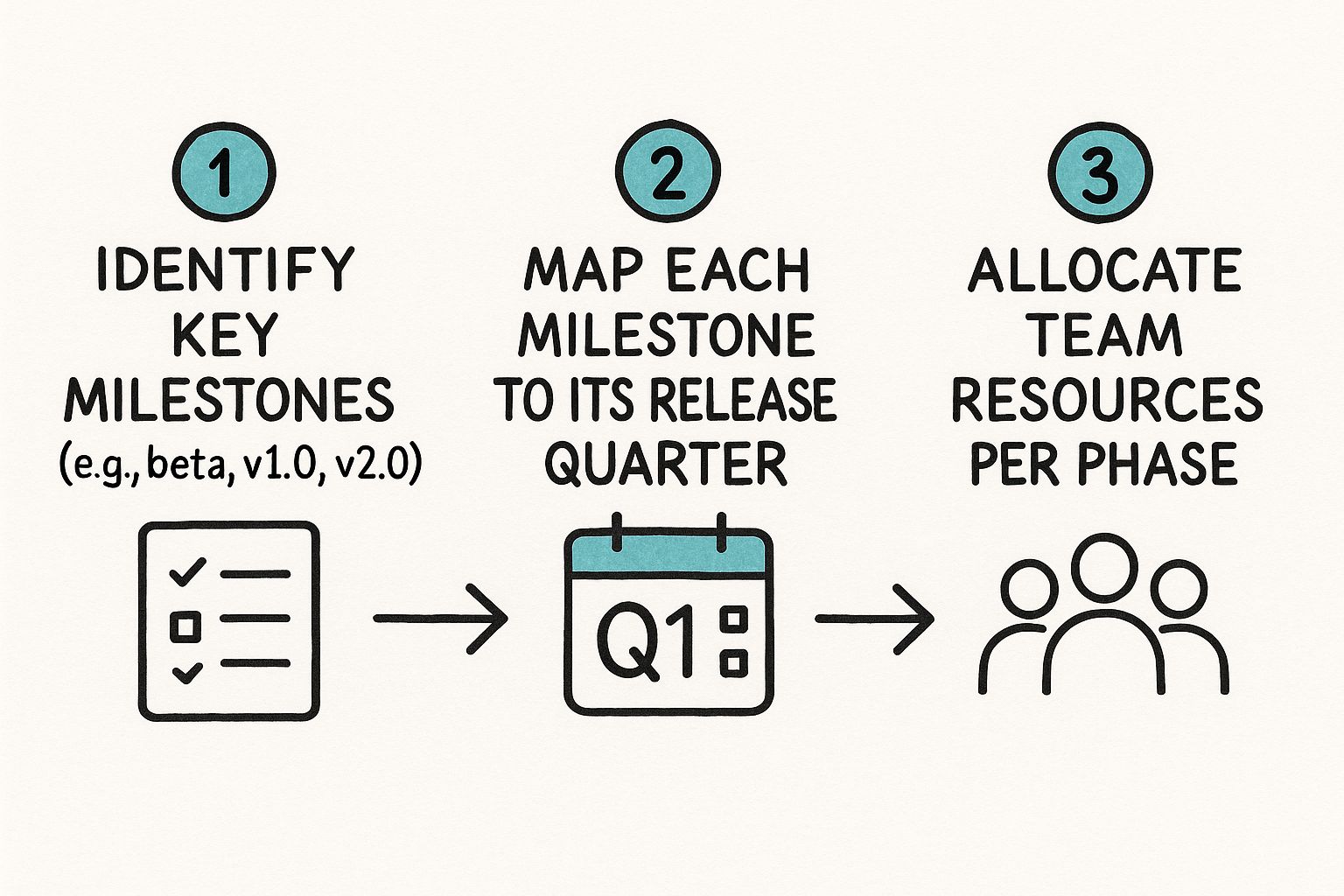
This visual process reinforces how you move from high-level milestones to the practical allocation of team capacity, turning abstract priorities into a concrete plan. This structured approach is becoming more critical as companies invest heavily in better planning tools. The global product roadmap software market was valued at approximately USD 1.5 billion in 2023 and is projected to grow significantly, driven by this very need for more efficient strategic planning. You can read the full research on the growth of product roadmap software to understand the market dynamics.
Ultimately, mastering prioritization is less about finding a perfect formula and more about developing strong judgment. It involves communicating your decisions with clear rationale, building trust with stakeholders even when you say "no," and knowing when to stick to your guns versus when to be flexible. It’s this skill that truly separates a wish list from a product roadmap that delivers results.
Choosing Tools and Formats That Actually Work
After you've defined your objectives and figured out your priorities, the next move is picking the right tools and formats to actually build your product roadmap. This choice is a big deal and can determine whether your roadmap is a living guide or a forgotten document. The goal isn't to find the software with the most bells and whistles. The best tool is the one that fits into your team's current workflow and helps you communicate clearly. I’ve seen teams make the mistake of buying a complex, expensive platform when a well-organized spreadsheet would have done the job better.
It’s all about matching the tool to your team’s size and the needs of your stakeholders. I remember an early-stage startup that ran its entire product strategy from a Trello board, and it worked perfectly for them. On the other hand, a large company I worked with needed the power of dedicated software like Roadmunk or Productboard to handle multiple product lines and their dependencies. The real question isn't "what's the best tool?" but rather, "what's the best tool for us, right now?"
Aligning Formats with Your Audience
Just as critical as the tool is the format you use to present your roadmap. A one-size-fits-all approach just doesn't work because different people need different information. Smart product leaders know how to create multiple views from a single source of truth, tailoring the presentation for each audience:
- For Executives: They need the 30,000-foot view focused on outcomes. Show them strategic themes, key business goals (like increasing market share by 10%), and major milestones on a quarterly timeline. Keep it visual and skip the heavy technical jargon.
- For Engineering Teams: They need to see how the roadmap connects to their sprints. This view should break down initiatives into epics and highlight key dependencies. It’s about giving them the "why" behind their work, not dictating the "how."
- For Sales & Marketing: These teams need to understand the customer-facing benefits and get a sense of release timing to plan their go-to-market strategies. Focus on the value proposition and the problems you're solving for users.
This screenshot from Roadmunk shows how a dedicated tool can create these different views from the same set of data, which is a game-changer for keeping everyone aligned.
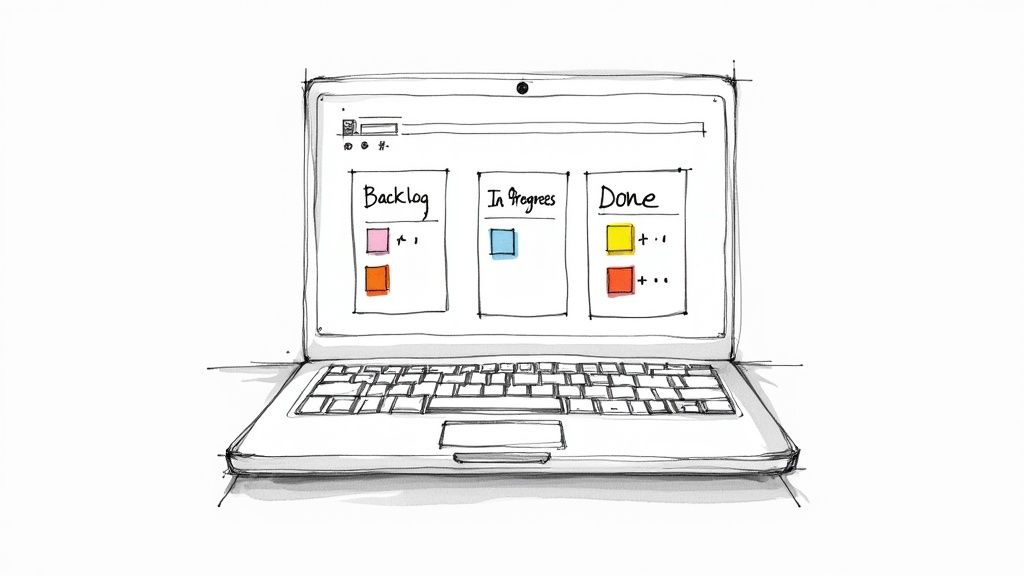
The real magic here is being able to pivot your roadmap's presentation—from a timeline for leadership to a swimlane view for developers—without creating separate, conflicting documents. This flexibility is what keeps everyone on the same page as plans inevitably change.
When you're looking at different roadmapping tools, it’s easy to get lost in feature lists. To help you choose wisely, I've put together a comparison of some popular options. This table breaks down what each tool is best for, its key features, and typical pricing.
Popular Roadmap Tools Comparison
Feature comparison of leading roadmap software platforms with pricing and use case recommendations
| Tool Name | Best For | Key Features | Pricing Range | Integration Options |
|---|---|---|---|---|
| Productboard | Centralizing user feedback and tying it to feature prioritization. | User insights hub, custom roadmap views, prioritization frameworks (RICE, value vs. effort). | ~$20-$80 per maker/month | Jira, Slack, Salesforce, Zendesk, Microsoft Teams |
| Roadmunk | Creating visually compelling, presentation-ready roadmaps for multiple audiences. | Timeline & swimlane views, master roadmaps, idea management, feedback portal. | ~$19-$99 per user/month | Jira, Azure DevOps |
| Aha! Roadmaps | Enterprise-level planning with a full suite of product development tools. | Goal-setting, capacity planning, detailed feature management, reporting. | ~$59-$149 per user/month | Jira, GitHub, Slack, Salesforce, Rally |
| Jira Product Discovery | Teams already heavily invested in the Atlassian ecosystem. | Direct integration with Jira Software, idea capture, custom fields, impact scoring. | Free for up to 3 creators, then ~$10/creator/month | Native Atlassian suite integration |
| Trello | Startups and small teams needing a simple, flexible, and low-cost solution. | Kanban boards, checklists, labels, power-ups for customization. | Free to ~$17.50 per user/month | Slack, Google Drive, Jira, and hundreds more via Power-Ups |
This table should give you a solid starting point for finding a tool that fits your team's scale and workflow. Notice how some tools are built for complex, enterprise-level planning, while others excel at simple, visual collaboration.
When you're evaluating your options, think beyond the features and consider these practical points:
- Ease of Adoption: How quickly can your team start using it effectively? If it requires days of training, people will resist it.
- Integration: Does it play nicely with the tools your team uses every day, like Jira, Slack, or Microsoft Teams?
- Collaboration: Can multiple people work in it at the same time and leave feedback easily? For remote and hybrid teams, this is non-negotiable. Many find it helpful to first master collaborative online whiteboards for initial brainstorming before moving ideas into a formal roadmap. If you're looking for more guidance on this, learning about effective collaboration tools can be a great first step.
The goal is to find a system that makes creating and sharing your roadmap easier, not another chore. Start simple, show the value, and then add more sophisticated tools as your needs grow. For a deeper look into this process, our guide to modern product management practices offers more perspectives. Choosing the right system ensures your strategic plan stays a living, useful guide for everyone.
Communicating Your Roadmap for Maximum Impact
A brilliant roadmap is useless if it's just sitting in a folder, misunderstood or ignored. The final, most important part of creating a product roadmap is knowing how to share it. This isn't just about sending an email with a link; it's about telling a compelling story that builds confidence, gets everyone on board, and keeps the team aligned, even when plans change. The aim is to make your strategic vision stick and feel real for everyone involved.
Tailoring the Message for Different Audiences
One of the biggest mistakes I see is presenting the exact same roadmap to everyone. Your executive team, engineering leads, and marketing department all have different priorities and need different levels of detail. A one-size-fits-all presentation will either bury stakeholders in irrelevant details or leave them with too little substance to act on.
A much better way is to create different views from a single source of truth. Think of it like a prism: one beam of light (your strategy) goes in, but multiple colors (audience-specific views) come out.
- For Executive Leadership: They care about the why and the when. Give them a high-level, theme-based roadmap that focuses on business outcomes. Directly connect your initiatives to company OKRs or revenue goals. Use visuals to show progress against these big-picture themes over the next few quarters. Forget the feature-level details and concentrate on market impact.
- For Engineering Teams: They care about the what and the how. Show them a more detailed view that links themes to specific epics or major initiatives. This isn't about assigning tasks but providing context so they can make smart architectural decisions. Highlighting dependencies between teams here is essential for preventing future bottlenecks.
- For Go-to-Market Teams (Sales, Marketing, Support): They care about the value. They need to grasp the customer problems you're solving and the benefits of upcoming releases. A view centered on customer value propositions, target personas, and general release timing helps them prepare campaigns, update sales materials, and write support docs ahead of time.
This need for clear, visual communication is why specialized tools are booming. The product roadmap software market, valued at around USD 1.2 billion in 2024, is projected to climb to USD 3.5 billion by 2033. This shows a strong trend: companies are investing in platforms that help them visualize and communicate strategy well. You can explore these insights on the product roadmap software market to understand more about this shift.
Mastering the Art of the Presentation
Once you have the right view for your audience, how you deliver it is just as important. A static presentation where you just read off a slide will lose people fast. When it's time to share your roadmap, think about using interactive presentation techniques to keep your audience engaged and make your message memorable.
Instead of just presenting, try to facilitate a conversation. Here are a few practical tips from my own experience:
- Start with the Vision: Always kick off by reminding everyone of the high-level product vision and the main goals for the period. This grounds the entire discussion in shared objectives.
- Tell a Story: Frame your roadmap as a story. "Last quarter, we solved X problem for our users. Based on that success and new feedback, our next chapter is focused on tackling Y, which will unlock Z for the business."
- Address the Unspoken Questions: Be proactive and answer the questions you know are on their minds. Be open about trade-offs. For example, "We chose to prioritize Initiative A over Initiative B because it has a larger impact on user retention, our key objective this quarter."
- Embrace Uncertainty: Don't present timelines as concrete promises, especially for items further down the road. Use broad terms like "Next" or "Later" to show direction without setting false expectations. This builds trust and gives you the flexibility to adapt as you learn.
Your Roadmap Success Blueprint
Turning your strategic plans into a successful product takes more than just good intentions; it requires a practical blueprint. This is where you bring everything together—the intelligence you've gathered, the objectives you've defined, and the priorities you've set. A great roadmap isn’t a static document but a living asset, one that evolves with your product and keeps your team aligned and motivated.
Creating a Living Document
First, shift your mindset from "planning" to "guiding." Your roadmap should be a dynamic guide, not a rigid set of instructions. This means building in mechanisms for regular review and adaptation. A common mistake is to create a beautiful roadmap and then forget about it for six months. Instead, you need to establish a clear rhythm for check-ins.
- Quarterly Reviews: At the start of each quarter, hold a dedicated session with key stakeholders. Go over the progress made against the previous quarter’s goals and confirm that the upcoming priorities still make sense. This is your moment to adjust course based on new market data or customer feedback.
- Monthly Syncs: Use these meetings with your core product and engineering teams to track progress against your themes. It’s a great time to celebrate wins and spot emerging roadblocks before they become serious problems.
- Continuous Feedback Loops: Don’t wait for formal meetings. Use tools like Slack or dedicated channels within your roadmap software to keep an ongoing conversation about progress and priorities.
This continuous process is what separates a roadmap that drives results from one that gathers dust. Product roadmap tools are essential here, as they improve coordination, align stakeholders, and provide the flexibility to revise plans based on real-world feedback. This evolution underscores the importance of roadmaps as dynamic guides for strategic decisions. You can learn more about how these tools empower dynamic product planning.
Measuring and Communicating Success
To keep everyone motivated and ensure your roadmap is delivering, you have to define and measure what success looks like. Every theme or major initiative on your roadmap should be tied to a specific, measurable outcome.
| Milestone Type | Success Metric Example | Communication Goal |
|---|---|---|
| Feature Launch | Achieve 1,000 active users within 30 days. | Celebrate the team's hard work and impact. |
| Objective Progress | Increase user retention by 5% this quarter. | Keep leadership confident in the strategy. |
| Process Improvement | Reduce time-to-market for small features by 15%. | Show operational efficiency gains. |
Celebrating these milestones is just as important as setting them. It reinforces the value of the team's work and keeps the momentum going. Recognize achievements publicly and tie them back to the roadmap, showing how individual efforts contribute to the larger strategic vision.
By combining actionable checklists, realistic timelines, and clear metrics, your roadmap becomes more than just a plan—it becomes the engine of your product’s growth.
Ready to build a roadmap that gets results and accelerate your leadership journey? As a product leader with over two decades of experience scaling high-growth companies, I help executives like you refine their strategy and build high-performing teams. Let’s create your playbook for success. Book a consultation with Matthew Mamet today.
Ready to drive more growth & achieve bigger impact?
Leverage my 25+ years of successes and failures to unlock your growth and achieve results you never thought possible.
Get Started

